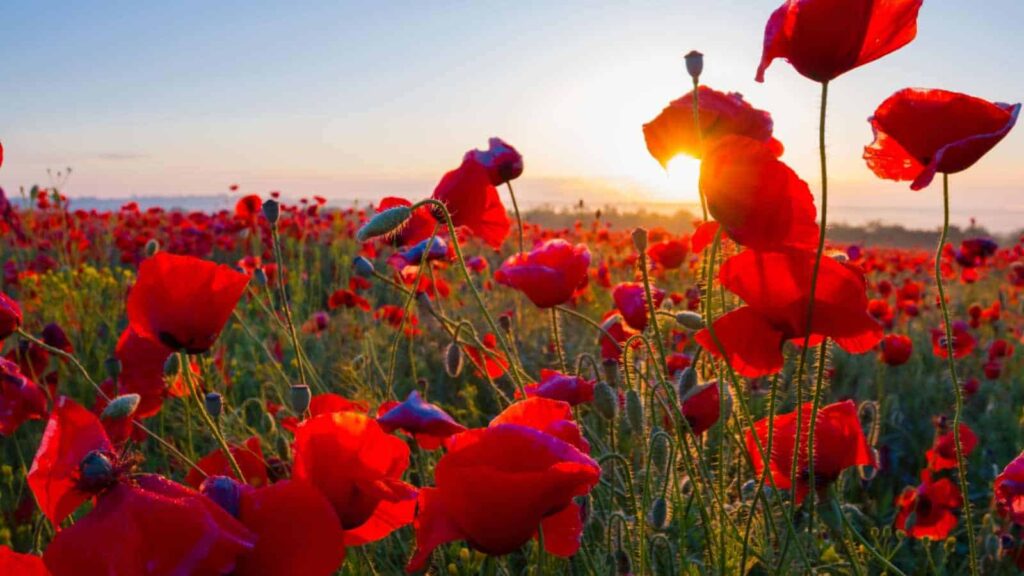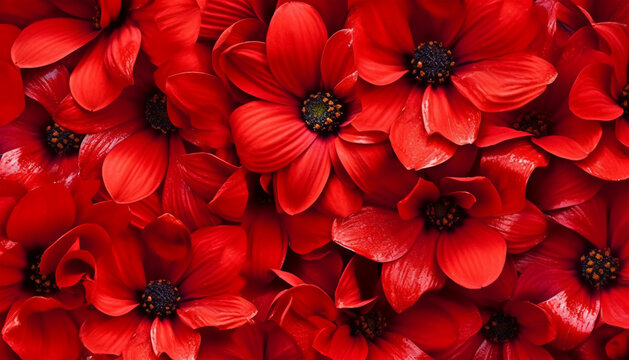A Comprehensive Guide Red Flowers are adored for their bold, vivid colors, ability to attract attention, and ability to elicit strong emotions. Any garden or flower arrangement can be made brighter by using red flowers like fiery roses and striking geraniums. This article provides a comprehensive look at the various red flower varieties, their significance, and cultivation and care practices.
1. The Appeal of Red Flowers:
The striking color of red blossoms, which can range from a bright red to a deep, dark red, is what sets them apart. They are an excellent choice for establishing focal points in gardens or adding dramatic flair to floral arrangements due to their intense color.
a. Red Flowers Color Spectrum:
In garden beds or arrangements, rich, dark reds like crimson are ideal for making bold statements. They exude a sense of opulence and sophistication.
Due to their lively appearance, the scarlet flowers known as “Bright Scarlet” are ideal for adding color and excitement to any room.
- The Restful Reds: Because of their effect, lighter colors like salmon and coral are great for creating a romantic, soft but still striking look.
b. Emotional Implications:
Red frequently evokes feelings of zeal, enthusiasm, and passion. These emotions can be evoked by red flowers, which also have a powerful visual impact in any setting.
2. Each of the numerous species of red flowers has its own set of characteristics and requirements for cultivation. Some popular varieties include:
a. Rose (Rosa) :
Roses are probably the most well-known red flowers because of their sophisticated blooms and extensive symbolism.

- Public Appearance: The bright reddish-cherry petals emerge from numerous layers of deep burgundy.
- Uses: ideal for flower arrangements, romantic bouquets, and formal gardens.
b. The Tulip, or the Tulipa:
Tulips are adored for their smooth, cup-shaped blooms.
- Public Appearance: elongated, slender petals that come in a variety of reds, like a delicate rose or a vivid crimson.
- Uses: ideal for cut flower arrangements, spring gardens, and seasonal displays.
c. Geranium (Pelargonium):
Geraniums are adaptable plants that spread to form clumps of flowers of striking colors.
- Public Appearance: Small, rounded, bright red flowers that frequently have a slight ruffled texture.
- Uses: ideal for colorful borders, hanging baskets, and container gardens.
d. Poppy (Papaver):
Poppies are well-known for their strikingly large and delicately arranged flowers.
- Public Appearance: dazzling red petals with a distinct dark community and the appearance of tissue.
- Uses: Suitable for use as cut flowers, wildflower gardens, and naturalized areas ### e. Hibiscus rosa-sinensis: The hibiscus flower’s large, striking blooms are well-known for their tropical appeal.
- Public Appearance: Large trumpet-shaped flowers in reddish-orange with a prominent center.
- Uses: ideal for tropical gardens, indoor pots, and accent plants.
3. The Symbolism of Red Flowers :
Red flowers frequently convey profound messages and have a lot of meaning.
a. Romance and Love:
Romantic scenes are frequently associated with red flowers. They are frequently given as a token of deep love and devotion on holidays like Valentine’s Day and anniversaries.
b. Energy and Passion:
The fiery red color is a symbol of energy and passion. In garden design, red flowers can bring life to a space or make a bold statement.
Perseverance and courage The color red is another representation of strength and courage. They are appropriate for recognizing achievements or milestones because they can be used to show support and admiration.
d. Celebration and Festivity:
Red flowers are frequently used in celebration and festivity arrangements due to their vivid color. They can make parties and events more fun and joyful.
4. Caring for Red Flowers:
Red flowers must grown in the right conditions. How to grow and maintain healthy red blooms is as follows:
a. Lighting Needs – “Full Sun”:
The majority of red flowers require six to eight hours of daily direct sunlight to flourish. This ensures vigorous growth and vibrant color.
- The “Slight Shade” Some varieties, like geraniums, can thrive in some shade, but they might produce fewer flowers.

b. “Well-Draining Soil”:
To avoid root rot and waterlogging, red flowers usually like soil that drains well. Include organic matter to improve drainage and soil structure.
pH of the soil is: For best growth, select soil with a pH between 6.0 and 7.0 that is slightly acidic to neutral. Test the soil and make any necessary adjustments.
c. “Consistent Moisture”:
Allow the top inch of soil to dry out between waterings to maintain a constant moisture level in the soil.
- Tolerance for Drought: Once established, someflowers, like poppies, can withstand drought. During dry periods, water less frequently.
Utilizing a Balanced Fertilizer for Fertilization: For vibrant blooms and healthy growth, use a fertilizer that is balanced and dissolves in water. When it comes to application rates and timing, follow the manufacturer’s instructions.
- Natural alterations: Compost or well-rotted manure can improve soil health and supply essential nutrients.
e. Pruning:
Red flowers require regular pruning to maintain their shape, eliminate diseased or dead growth, and make room for new blooms.
- Sanctions: To prevent the formation of seeds and encourage continued blooming, remove spent flowers.
Color combinations, also referred to as “Contrasting Colors”, Combine the flowers with white or green flowers to bring out their vivid hues and create striking visual contrasts.
- Plans with the “monochromatic” label: For a look that is both cohesive and harmonious, use a variety of red flowers.
Garden Design Fundamentals:
In order to draw attention and create visual interest, use large or striking flowers as focal points in garden beds or borders. Arrangements of flowers made from “Cut Flowers”: Red flowers add vibrancy and elegance to any display and make stunning cut for bouquets and arrangements.
- Decor for the interior: Potted flowers can make your decor happier and brighten up interior spaces.
Conclusion
Red flowers are an eye-catching and vibrant addition to any floral arrangement or garden. Gardeners and florists adore them for their adaptability, vibrant colors, and abundance of symbolism. You will be able to fully appreciate these vibrant blooms and enhance both your indoor and outdoor spaces if you are familiar with the various varieties of flowers, their requirements for care, and how to incorporate them into your garden.







